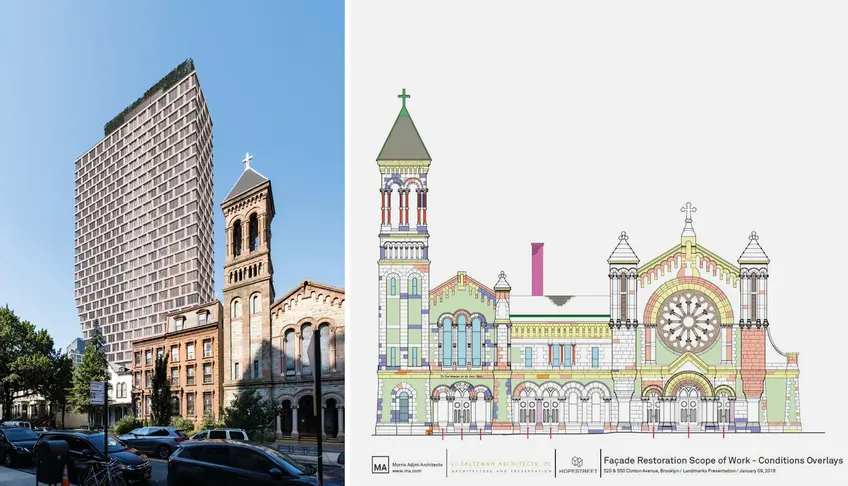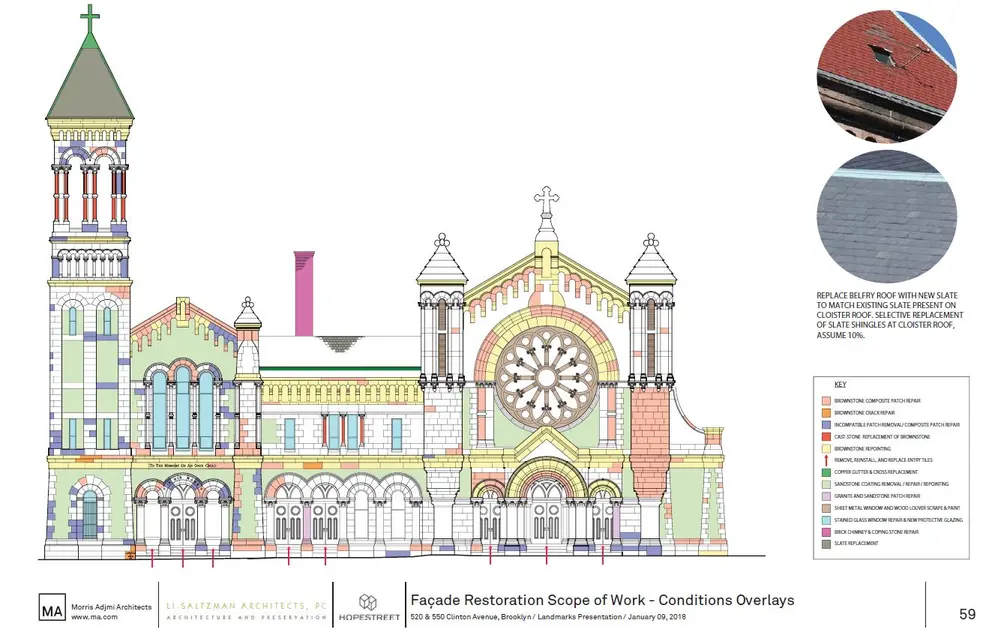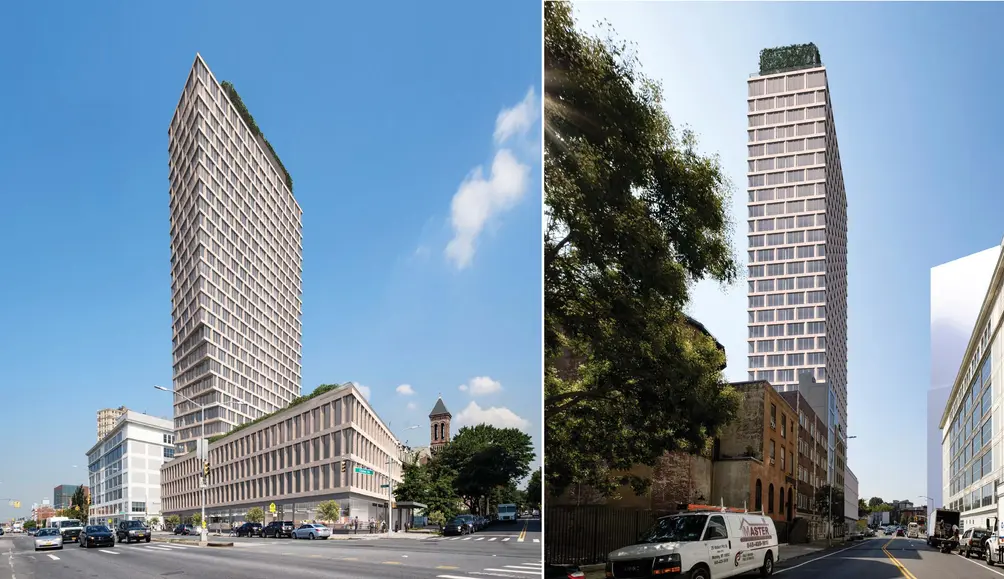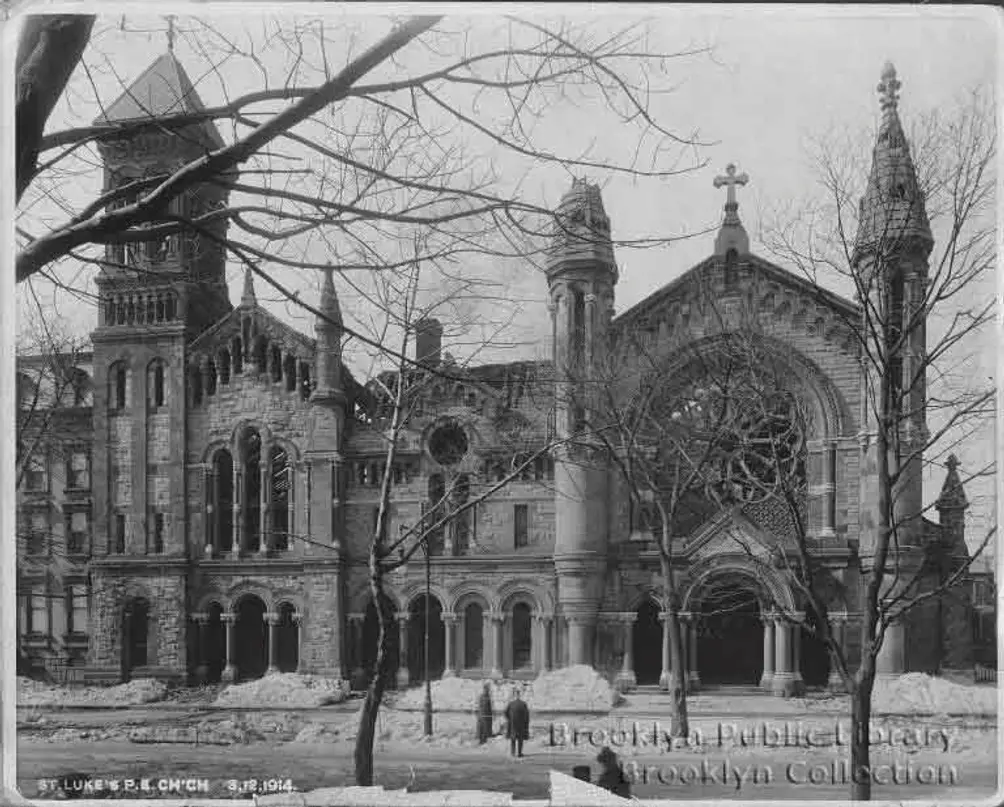 Renderings and drawings credit: Morris Adjmi Architects and Li Saltzman Architects
Renderings and drawings credit: Morris Adjmi Architects and Li Saltzman Architects
The Landmarks Preservation Commission asked the team seeking approvals for the restoration of the Church of St. Luke and St. Matthew along with the transfer of 60,000 square feet of the church’s development rights to come back with refinements due to concerns about the “extreme use of composite repairs” in the restoration. The patching is to replace eroded brownstone elements found throughout the 125-year-old landmarked structure. One commissioner believed the use of the material is not reflective of a first-class restoration effort and ultimately asked the architect to return with assurances that matching materials will be used.
Situated at 520 Clinton Avenue, near the junction of Clinton Hill, Fort Greene, and Prospect Heights, the Episcopal church was finished in 1891 and was designed by John Welch in a vigorous Romanesque Revival style. The AIA Guide to New York City describes the building's "great facade" as "Eclecticism gone berserk," while the New York City Landmarks Preservation Commission's Guide to New York City Landmarks calls it "one of the grandest ecclesiastical buildings in Brooklyn."
 The Church of St. Luke and St. Matthew
The Church of St. Luke and St. Matthew
Present at yesterday’s hearing was the church’s reverend, Julie M. Hoplamazian, who spoke about the church’s interfaith programs, community programs and its role as a disaster relief center. As the largest building in the local diocese, the reverend noted the gem is a marvel to look at as well as to maintain. The church's commissioned designers, Li Saltzman Architects, presented plans for the comprehensive restoration effort. Due to its age and two major fires, defects include leaks, poor drainage, deterioration and spalling of brownstone elements/rusticated sandstone pieces. Many of the building's stained glass windows also need to be restored.
 Credit: Li Saltzman Architects
Credit: Li Saltzman Architects
To provide funds for the extensive restoration and to maintain the building long term, the church has partnered with Hope Street Capital to facilitate a development rights transfer to a development site at 550 Clinton Avenue. The property is two buildings down from the church and spans the Atlantic Avenue block front between Clinton and Vanderbilt Avenues. The mostly-residential tower is being designed by Morris Adjmi Architects and will need additional waivers and a rezoning from City Planning to build the 29-story, 237,000-square-foot building. They envision the building to have a large green roof and up to 45 units reserved for affordable housing. The developer will also seek to waive parking requirements and lower the tower’s streetwall minimum to preserve a view of the church’s belfry from southern vantage points. Without the development rights transfer, the planned tower would be approximately 10 floors shorter.
 Tower proposed for 550 Clinton Avenue (Morris Adjmi Architects)
Tower proposed for 550 Clinton Avenue (Morris Adjmi Architects)
 550 Clinton Avenue and the church in context with a built-out Pacific Park plan
550 Clinton Avenue and the church in context with a built-out Pacific Park plan
Overall, the commissioners were receptive to the plan and were pleased with how private development can benefit the city’s landmarks in a symbiotic way. “The development is viable because of the church. It will maintain the historic building and celebrate the context of the place,” said one commissioner. The commissioners were elated the tower will not be all glass (it will be pre-cast concrete) and they did not object to the scale of the 312-foot building since a parade of taller/similar-in-height towers are planned in the Pacific Park development across Atlantic Avenue.
Some commissioners did think the tower’s design was awkward, unresolved and needed to be fine-tuned. Above the podium, the tower feathers outward to frame the church’s belfry from certain angles. Some thought the nod felt heavy. “It feels like the tower is falling on the belfry,” said one commissioner. One local resident asked the commission to reject the application, saying the proposed structure is not harmonious with the church and will dominate the belfry from Clinton Avenue and the Clinton Hill Historic District.
Ultimately, the commission took no action towards approving or rejecting the application. They thanked the team for an “incredibly robust restoration presentation,” but the usage of composite materials with their limited lifespans didn’t sit well with some. “This is a very, very important building and deserves a first-class restoration.”
 The St. Luke and St. Matthew (Brooklyn Public Library)
The St. Luke and St. Matthew (Brooklyn Public Library)

New Developments Editor
Ondel Hylton
Ondel is a lifelong New Yorker and comprehensive assessor of the city's dynamic urban landscape.

 6sqft delivers the latest on real estate, architecture, and design, straight from New York City.
6sqft delivers the latest on real estate, architecture, and design, straight from New York City.
